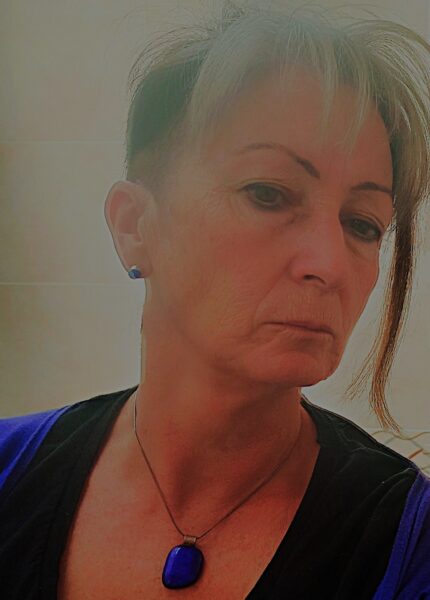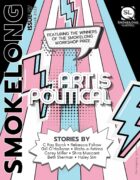Your story begins at a large outdoor festival with the main character dressed as a badger. I’ll admit I had to look up the Reading Festival, for a minute I thought it might actually center around reading, with authors dressed up as their favorite furry characters (my idea of nirvana), but alas! Still, I felt my cool factor rise as I learned about Gogol Bordello and The Libertines. Any special connection with those bands, or with the Reading Festival? Why did you choose this setting for the beginning of your story?
I went to Reading Festival in my forties with my 13-year-old son, but when he outgrew it at 16, I kept going. Reading’s for indie adolescents and old (male) metal fans, so I looked completely out of place, which added to the fun. I loved Gogol Bordello; the music and their wild abandon expressed an emotional frenzy I felt at the time but couldn’t articulate. When I met Eugene Hutz, I had some intelligent questions to ask about Romani rights, but I collapsed into a breathless sycophant. The Libertines was more my son’s band, but I enjoyed their chaos. Reading seemed an appropriately reckless setting for the idea of costume as playful hedonism before the narrative turns darker.
There’s a line at the end of the first paragraph that stands out, “I want to laugh, but I won’t go out-of-character, not even for The Libertines.” That line invites the reader into an overarching theme in your story, the duality of “pretend,” of “becoming another.” And your character, of course, wears a badger costume. Can you free associate—don’t think too much about it, and just tell me—what traits, images, ideas, or thoughts arise for you, when you think ‘badger’?
- The UK’s controversial badger cull.
- Badgers have sixteen different calls for social interactions!
- The excitement of seeing one trotting across a country lane one evening.
- My fringe has gone white, but the rest of my hair remains resolutely dark, meaning I’ve been likened to a badger!
- Being a Beast by Charles Foster, a fascinating book, simultaneously ridiculous and serious, in which he describes living as different animals, including a badger.
There’s a lot of costuming in your story, moments of hiding and disguising, and then in select moments, undressing, peeling off the mask, like the memory of the lost brother. We begin to understand how the main character is drawn to disguise as a coping mechanism. Her own mother “became a Banshee and she’s remained in character ever since”—a haunting line, in the way it suggests how we are all pretending to play different parts, attempting to cope with the stress and trauma of being human. I’m curious about your own experiences.
I’ve never taken part in a role-playing game, but I’ve worn a badger costume and had great fun hiding behind a mask and doing things I wouldn’t otherwise dare. But don’t we all use disguises to cope with human struggles? I’ve worn sharp suits to give me confidence when teaching, a smile to cover up intense pain. I wanted to push it to the edge.
I’m intrigued by that last line: “Come into the undergrowth.” Such an amoebic word, full of possible double meanings. What does the “undergrowth” suggest to you? How does that feel, to land and end on that last sentence and image, “undergrowth”?
I’m not always happy with my endings, but I like this one. In my own life, I was a fan of therapy, but then someone I loved died a sudden death, and therapy didn’t help, so I stopped and hid in a safe emotional place until the pain subsided. That was my undergrowth. My narrator doesn’t want to face her partner’s pain any more than her own. If she listens to him, maybe she’ll then be faced with the possibility that the youths who stabbed her brother were human, even experienced their own pain. She sounds harsh, but while wanting her partner to shut up, maybe she also cares and is saying, “I know another way: life’s short—let’s play.” I wanted the reader to be taken into the undergrowth at the end too, into the messiness of an ambiguous ending where the light will not illuminate and resolve the conflict between the couple or within the female character.
Lastly, how did this story come to you? What was your process? And is there anything you would like to share with us that I haven’t asked?
It began as a SmokeLong writing task—a roleplay that becomes more sinister.
Flashes are like dreams, snippets of your own life, something glimpsed from a train, subconscious thoughts, symbolism, other stories you’ve read—but the good ones draw on what preoccupies or unsettles you. I’m fascinated by justice and the impossibility of justice, whether in everyday life or wars. Justice is such a lofty word, but if you’ve been badly hurt, can you rise above a wish for revenge? When I read about victims who manage this, I’m deeply moved. We need courts, but courts are also composed of fallible humans. And I was intrigued by the 2024 BBC Reith Lectures on violence, which are worth a listen.
I’ve also experienced overwhelm and compassion fatigue. I’ve done a lot of caring in my life, in different settings, but nowadays, I just want to play. I think those close to me would say I’m kind, and I hope that’s true, but maybe I carry a blade now, though it’s just a costume prop, of course. It took me a long time to get going with this flash. I researched role-playing games, I listed all the times I’d worn a costume. On my second draft, I realized that the photo (initially introduced near the end when the narrator goes indoors to fetch the tutu) was the obvious trigger for her to go beyond costume and almost mutate into a badger. That was when it came together.



 The core workshop of SmokeLong Fitness is all in writing, so you can take part from anywhere at anytime. We are excited about creating a supportive, consistent and structured environment for flash writers to work on their craft in a community. We are thrilled and proud to say that our workshop participants have won, placed, or been listed in every major flash competition. Community works.
The core workshop of SmokeLong Fitness is all in writing, so you can take part from anywhere at anytime. We are excited about creating a supportive, consistent and structured environment for flash writers to work on their craft in a community. We are thrilled and proud to say that our workshop participants have won, placed, or been listed in every major flash competition. Community works.